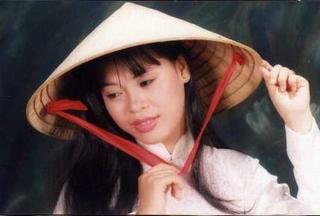 |
|
 |
Wednesday, May 11, 2005
Sinh To Hoa Qua Tuoi
We went back to the Pho To Tich street to eat fruit shake again. This time we chose a stall that sell Sinh To Hoa Qua Tuoi for slightly cheaper price, VND 6,000. There was a slight different in ingredients for the fruit shake, but it was as delicious!
Shopping at Old Quarter Hanoi
Old Quarter is located at Hoan Kiem district, and known as Pho Co in Vietnamese. Enclosed by Ha Noi Citadel, Hoan Kiem Lake and the Red River, the Old quarter is also famously known as the 36 Pho Puong (36 streets), and its history spans 2000 years. In the 13th century, 36 guilds established themselves here with each taking a different street. Street names reflect the type of merchandise being made/sold. Nowadays, some of the streets have taken up new commodities, but still cluster together along a single street - Hang Can (once scales, now stationary), Hang Dau (once oil, now shoes), Hang Buom (once sailcloth, nowconfectioneryy and wine) and Thuoc Bac (once medicine, now tools), for example. While some still retain the names as of the original trades – Hang Ma (Votive Paper Decorations Street), Hang Gai (Silk Street), Hang Thiec (Tin Street), and Hang Dong (Bronze Street).
Actually there is now more than 70 streets in Old Quarter. Some researchers believe that the number 36 came from the 15th century when there might have been 36 guild locations, which were workshop areas, not streets. When streets were later developed, the guild names were applied to the streets. Others attribute the 36 to a more abstract concept. The number nine in Asia represents the concept of "plenty". Nine times the four directions makes 36, which simply means "many". Most street name starts with "Hang", which means merchandise or shop.

Hang Ngang (Transversal Street) is lively at night, has a lot of shops selling clothes.

Cau Go Street, which means "Wooden Bridge", is located one block north of the Lake of the Restored Sword (Hoan Kiem Lake), and was in fact the location of a wooden bridge. About 150 years ago, the bridge crossed a thin stream of water connecting the Thai Cuc Lake with the Lake of the Restored Sword. Dyers from the neighboring Silk Street (Hang Dao / Hang Gai) set out their silk to dry or bleached their fabric beside the bridge. Under the French occupation, the lake and stream were filled as health measures and to increase buildable land. The little wooden bridge became a regular street.
Cau Go today is a commercial street specializing in womenÂs accessories.

Immediately assembled the shoe for the customers.
For Old Quarter street name description, refer here.
Actually there is now more than 70 streets in Old Quarter. Some researchers believe that the number 36 came from the 15th century when there might have been 36 guild locations, which were workshop areas, not streets. When streets were later developed, the guild names were applied to the streets. Others attribute the 36 to a more abstract concept. The number nine in Asia represents the concept of "plenty". Nine times the four directions makes 36, which simply means "many". Most street name starts with "Hang", which means merchandise or shop.

Hang Ngang (Transversal Street) is lively at night, has a lot of shops selling clothes.

Cau Go Street, which means "Wooden Bridge", is located one block north of the Lake of the Restored Sword (Hoan Kiem Lake), and was in fact the location of a wooden bridge. About 150 years ago, the bridge crossed a thin stream of water connecting the Thai Cuc Lake with the Lake of the Restored Sword. Dyers from the neighboring Silk Street (Hang Dao / Hang Gai) set out their silk to dry or bleached their fabric beside the bridge. Under the French occupation, the lake and stream were filled as health measures and to increase buildable land. The little wooden bridge became a regular street.
Cau Go today is a commercial street specializing in womenÂs accessories.

Immediately assembled the shoe for the customers.
For Old Quarter street name description, refer here.
Different Dinners - Cha Ca and Bun Bo

I initially agreed with Adeline to have dinner at Cha Ca La Vong, at Pho Cha Ca, which is very famous. But after saw the price of VND 70,000, I felt it's too much expensive and decided to give it a miss, and located other cha ca shop instead.

Adeline prefered to dine at Cha Ca La Vong, and here the dishes of cha ca.

I tried to locate a cha ca shop at Duong Thanh. However, the shop no longer existed. So I settled my dinner with Bun Bo Nam Bo at 65 Hand Dieu, which made of wheat noodles tangled up with citrus-scented herbs, beefs, peanuts and lime juice for around VND 15,000.
Xich Lo (Cyclo)

Due to the very hot weather, we decided not to walk back to our hotel. So we decided to take either a taxi, motorcycle (xe may or xe om) or xich lo (3-wheeled pedicab or trishaw) to go back. After leaving Four Pillars of Temple of Literature, a xich lo driver was approaching us. We bargained from VND 50,000 to VND 20,000. It was very interesting and exciting to see how xich lo managed to find a winding route among so many traffic on the road.

The Xich Lo and the driver. At the end, we paid him VND 10,000 more. The whole fare of VND 30,000 was excessive, while normally VND 5,000 is enough. But I was appreciative as I was getting unbearable with the heat.
Temple of Literature and Royal College

Temple of Literature (Van Mieu) was built in 1070 during Emperor Ly Thanh Tong to honor scholars and literary men, and was dedicated to Khong Tu (Confucius). In 1070, the Royal College (Quoc Tu Giam), Vietnam's first university, was founded here to educate the children of court mandarins, which remained until 1802 when the national university was moved to the new capital, Hue. Here is the entrance gate to temple complex, which reserved for the royalties.

Khuc Van Cac open pavilion which provides space for study and leisure.

Dai Trung Gate or Gates of Talent and Virtue, as view from the inside temple.

Thien Quang Tinh pond and after it, Dai Thanh (Great Success or Synthesis) Gate, which leads into the temple precinct. The flag with 5 colours which each represents an element of the nature: metal, wood, water, fire and earth.

One of the 82 Tortoise Stelae which recorded names, birth places and achievements of the 1306 successful triennial examination candidates. All of them was erected between 1442 and 1778. The Tortoise Stelae pavilions are on both sides of the pond.

Courtyard of the temple and the Bai Duong (House of Ceremonies).

Large bonsai in front of the building to the right of sanctuary.

A statue at the courtyard of the Temple of Literature.

Rafters in the main temple sanctuary were constructed without nails or screws. It's interesting to note also how the building overhanging eaves help to keep these buildings cool; large doorways are also important in cooling the buildings. In the winter, when it is cold in Hanoi, the sun is lower and heats the inside.

The main temple sanctuary of Temple of Literature with stork statues, symbolizing longevity.

Inside Temple of Literature sanctuary, housing statue of Confucius and his four greatest disciples.
Entrance fee to the Temple of Literature: VND 5,000.
Summer Weather in Hanoi
My feared nightmare became true. The hot and humid weather in Hanoi was always a big consent to me. Worse, the weather today was even hotter than I imagined, reaching 39 ºC. I was sweating non stop just by doing nothing and stood under shade! It's very tiring and uncomfortable to roam around Hanoi at this steamy weather. Thus we skipped a lot of attractions in Hanoi and even cut short the time spent outside just to get back to hotel room for the comfort of air-conditioning.
Quan Thanh Pagoda

There are a few pagodas around West Lake. We passed thru Quan Thanh Pagoda (Den Quan Thanh) without went in... the hot steamy summer weather in Hanoi was taxing a heavy toll on our energy, and hence the mood to visit the sights. Anyway, Quan Thanh Pagoda was built by Emperor Lo Thai To during the 11th century. Of course, entrance fee required to go in, as almost any other non Ho Chi Minh related sights in Vietnam. About 150 meters towards West Lake from here, along Duong Thanh Nien, there is also Tran Quoc Pagoda (Chua Tran Quoc).
West Lake (Ho Tay)

West Lake located at Tay Ho District is about 500 hectares, a 20 minutes walk north of Ho Chi Minh Mausoleum. At the time of our visit, there was nothing much interesting here except few pagodas, but it should filled with Vietnam's youth by evening.

Another view of West Lake

Beautiful tree-line boulevard Pho Phan Dinh Phung that leads to Ho Tay (West Lake)
Chao and Coconut Drink

We walked to the West Lake at Tay Ho district. All restaurants here by the West Lake was pretty expensive. So we settled our lunch at the only food stall in sight, had a delicious chao (rice porridge) and a no taste coconut drink.

The stall owners opened the coconut for us, as the initial opening was just enough for us to drink only. The coconut meat was very very hard, it's not possible to eat!
Dien Huu Pagoda

Dien Huu Pagoda is just a few steps away from One Pillar Pagoda, but often overlooked by tourists. We managed to come to here by following the university students, as I assumed they should be studying tourism.

The shrine inside the Dien Huu Pagoda
One Pillar Pagoda (Chua Mot Cot)
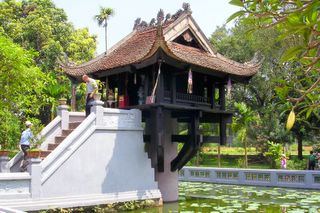
Right beside the Ho Chi Minh stilted house is One Pillar Pagoda, one of the few structures remaing from the old Thang Long. One Pillar Pagoda is dedicated to Quan Am, the goddess of mercy, after Emperor Ly Thanh Tong dreamed about the goddess sat on a lotus flower and offered him a son. And surprise, soon a boy was borned to him. The pagoda was destroyed by French in 1954 but has since been rebuilt.

Vietnamese girls worshiped at One Pillar Pagoda

A Buddhist shrine behind the One Pillar Pagoda, which located very conveniently beside the Ho Chi Minh stilted house.
Ho Chi Minh's Stilted House

In 1958, Ho Chi Minh moved into this simple stilted house near a carp pond, after refusing to stay in Presidential Palace. Ho Chi Minh stayed here until his death at 1969.

A corner of the Ho Chi Minh stilted house. The house was built near the Presidential Palace so that he would feel more with the people.
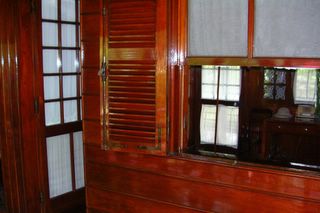
A peek into Ho Chi Minh stilted house. You won't be able to go in, everything is covered by glass.

The house that stores car used by Ho Chi Minh. There are several other exhibitions that, together with the stilted house, directly link from Ho Chi Minh mausoleum via Presidential Palace. There is clear signs along the way, if not just follows the crowd.

The carp pond beside Ho Chi Minh stilted house. Uncle Ho Chi Minh used to summon the fish for feeding by clapping his hands.
Presidential Palace

Presidential Palace was residence of the Governor-General of French Indochina before been served as a state guest house since 1954. Ho Chi Minh believed the building should belong to the people and chose to live in an electrician's hut on the ground. The Presidential Palace is not opened for visitors, so we could only glanced from afar.
Ho Chi Minh Mausoleum
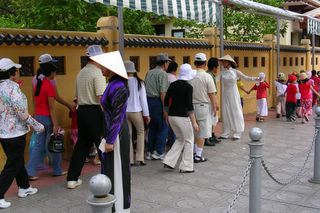
Ho Chi Minh Mausoleum, or in Vietnamese, Lang Ho Chi Minh, is where the remains of Ho Chi Minh (despite against his wish to be cremated) are kept. He is venerated as national hero and father of the Vietnam. There seemed to be 2 entrances to the Mausoleum. The entrance that we were, the queue was mainly formed by Vietnamese, and occasionally tourists came by walking. Adeline paid VND 4,000 each which until now I still don't know what it was for. Anyway, this was the first time in Vietnam that I saw Vietnamese girls in full traditional long dress costume.

Chu Tich (President) Ho Chi Minh Mausoleum. The corpse of Ho Chi Minh was very well preserved, but the environment was utterly creepy. Can't stayed long inside the mausoleum though, as the queue kept moving around the embalmed corpse of Ho Chi Minh. The enter the mausoleum, respectable attire is needed. There is a stand before the gate entrance that rents (or might be borrows) some cover-up clothes.
Note: No camera, phone and drink allowed inside the mausoleum. It's best to keep this things at a stand after the gate entrance, as they will automatically transferred your belongings to another stand that located right after the exit of mausoleum. So you can take your belongings there and continue the tour to other sights instead of walking all the way back to the entrance again. Open daily from 7.30 am or 8.00 am till around 10.30 am to 11:30 am.
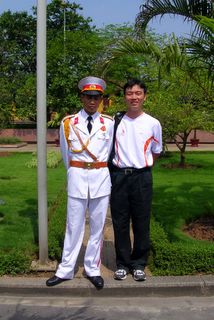
The white-uniformed soldiers at the Ho Chi Minh Mausoleum. Inside the mausoleum, they kept 'harassed' us to keep silent and maintain proper posture, and 'chased' us to move forward.











